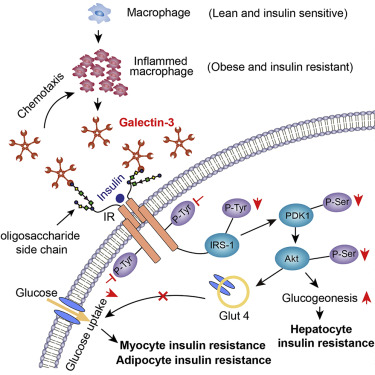|
|||||||||||||||
|

CLICK ON weeks 0 - 40 and follow along every 2 weeks of fetal development
|
||||||||||||||||||||||||||||
Insulin resistance reversed by removal of Gal3 protein By removing the protein galectin-3 (Gal3), a team of investigators were able to reverse diabetic insulin resistance and glucose intolerance in mice used as models of obesity and diabetes. Binding to insulin receptors on cells, Gal3 prevents insulin from attaching and resulting in insulin resistance. Led by Jerrold Olefsky MD, professor of medicine in the Division of Endocrinology and Metabolism at University of California San Diego School of Medicine, this investigation revealed how genetically removing Gal3 — or using pharmaceutical inhibitors — insulin sensitivity and glucose tolerance could be returned to normal, even among older mice. However, their obesity remained unchanged.
Olefsky and other researchers are studying how chronic tissue inflammation leads to insulin resistance in type 2 diabetes. The paper, published in the journal Cell on November 3, explains why inflammation requires macrophages — specialized cells that destroy targeted cells. In fat — 40 percent of cells are macrophages. Macrophages secrete Gal3, which acts as a signal to attract more macrophages — which results in even more Gal3.
Gal3 has previously been connected to other diseases. Olefsky will continue to study Gal3 depletion as a possible therapeutic target for nonalcoholic steatohepatitis (a type of fatty liver disease, characterized by inflammation of the liver with fat accumulation) as well as heart and liver fibrosis. Abstract Highlights Keywords: Study co-authors include: Pingping Li, Chinese Academy of Medical Sciences, Peking Union Medical College and UC San Diego; Shuainan Liu, Zhufang Shen, Bing Cui, Lijuan Kong, Shaocong Hou, Xiao Liang, Chinese Academy of Medical Sciences, Peking Union Medical College; Min Lu, UC San Diego, and Merck Research Laboratories; Gautum Bandyyopadhyay, Dayoung Oh, Andrew M. Johnson, Dorothy Sears, Wei Ying, Olivia Osborn, Joshua Wollam, UC San Diego; Takeshi Imamura, Shiga University of Medical Science; Salvatore Iovino, Martin Brenner, Merck Research Laboratories; Steven M. Watkins, Lipomics Technologies, Inc. |
Nov 17, 2016 Fetal Timeline Maternal Timeline News News Archive  Chronic tissue inflammation leads to insulin resistance in type 2 diabetes. Binding to insulin receptors on the cell membrane, Gal3 attracts inflammed macrophages. Image Credit: University of California San Diego School of Medicine
|
||||||||||||||||||||||||||||

